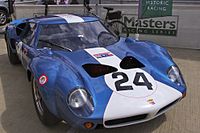Colotti Trasmissioni
Colotti Trasmissioni (Colotti Transmission) is an Italian mechanical engineering firm located in Modena, Italy. It specializes in gears,
History 1958-1979
After building a GP car for
Rob Walker asked Colotti to analyse and modify the front suspension of two Lotus racing cars belonging to Rob Walker Racing, and the plausible result prompted Rob Walker to let Colotti review the design of his own Grand Prix car, Walker Special, which was being built at the time. With the new 1.5-liter Formula One regulation going into effect for the 1960 season, Colotti designed and built the T.32 5-speed and T.34 6-speed transaxles. These weighed less than 35 kg and were suitable for lower-torque, high-rev 1.5-liter engines mounted behind the driver.
Outside of the racing field, Colotti worked under the name G.S.D. (Gear Speed Developments), such as on a transmission of a Hovercraft for Britten-Norman of Isle of Wight, and a power take-off/transfer system for the mixer drum on Cement mixer trucks, which replaced the long chain drives previously used.
Francis and Colotti knew the shortage of
Colotti, whose company name had become Colotti Trasmissioni (Colotti Transmission) by this time, researched the issue, and developed and patented a unique mechanism called Coppia-Frenata to limit the slip on the differential gears. This limited-slip differential became popular among the Formula 1 and other racing teams, being one of the few viable alternatives to the ZF product.
In 1962,
The T.37 (with no gears blocked off) was later used by Eric Broadley on the Lola Mk6, and by Ford for the Ford GT40 in their joint project with Broadley.
-
Lotus 18/21 with body removed
-
Lotus 29
-
Lola Mk6
-
4th prototype Ford GT40
1980-present

Colotti Trasmissioni was also active in the Rally sector, by developing a new kind of limited-slip center differential for four-wheel drive competition cars. This torque splitting/proportioning device is patented as Split-Diff.
Ferrari 125
Valerio Colotti worked for Ferrari in the late 1940s and early 1950s, and worked on engineering the chassis and transmission of their first own GP car design under Enzo Ferrari, Aurelio Lampredi, and Gioacchino Colombo. In light of this, Piero Ferrari asked Colotti Trasmissioni to build an exact replica of the Ferrari 125, with the original engine and using drawings provided by the Maranello factory. The first-ever Ferrari-built Grand Prix car had been lost, and the completed replica currently resides in Museo Ferrari in Maranello, alongside newer Ferrari F1 machines.

See also
References
- ^ "Inside Dan Gurney's 1963 Lotus 29 Ford". Retrieved 2013-07-01.
- ^ "Company". Archived from the original on 2013-08-27. Retrieved 2013-06-28.




